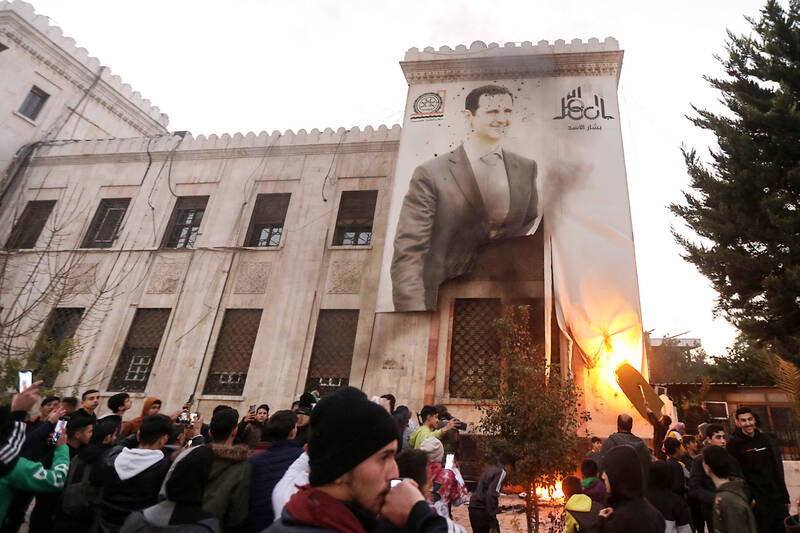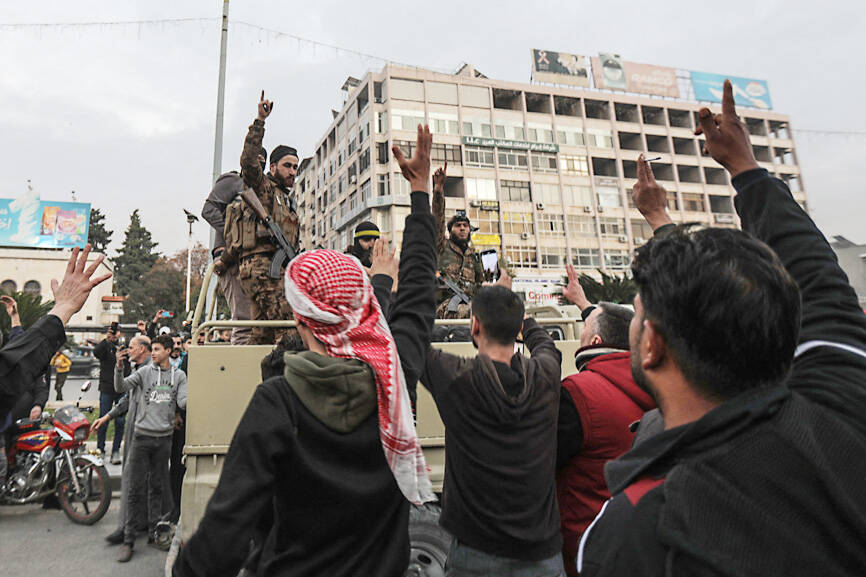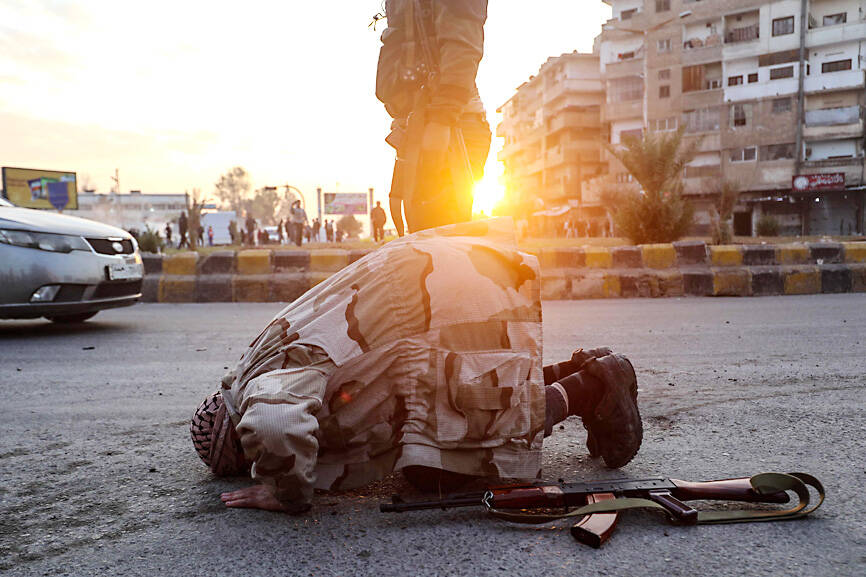SYMBOLIC: Hama was the site of a deadly government crackdown in 1982, which was a formative experience for anti-al-Assad fighters. Its capturing has symbolic meaning
AP, BEIRUT
It was one of the darkest moments in the modern history of the Arab world. More than four decades ago, then-Syrian president Hafez al-Assad launched what came to be known as the Hama Massacre.
Between 10,000 and 40,000 people were killed or disappeared in the government attack on the central Syrian city. It began on Feb. 2, 1982, and lasted nearly a month, leaving the city in ruins.
The memory of the government assault and the monthlong siege on the city, which at the time was a stronghold of Syria’s Muslim Brotherhood, remains visceral in Syrian and Arab minds.

Residents in the Syrian city of Hama set ablaze a large banner bearing a picture of Syrian President Bashar al-Assad hanging on the facade of a municipal building after anti-government fighters took control of the west-central city on Thursday.
Photo: AFP
Now Islamist insurgents have captured the city, tearing down a poster of Hafez al-Assad’s son, Syrian President Bashar al-Assad, and swarming security and government offices — scenes unimaginable 40 years ago.
The moment carried great symbolism in Syria’s long-running civil war, which began 13 years ago, but many say is rooted in Hama.
Hama, Syria’s fourth-largest city, is known for its quaint waterwheels, a landmark attraction along the banks of the Orontes River.

Residents in the Syrian city of Hama welcome anti-government fighters after they took control of the west-central city on Thursday.
Photo: AFP
In the early 1980s, the city’s name became synonymous with killings.
It was the scene of Muslim Brotherhood-led antigovernmental attacks that targeted military officers, state institutions and ruling party offices. In February 1982, Hafez al-Assad ordered an assault on the city to quell the unrest.
In a matter of days, government warplanes destroyed most of the city, opening the way for ground troops.

A Syrian anti-government fighter kneels to pray upon entering the west-central Syrian city of Hama on Thursday.
Photo: AFP
Hafez al-Assad’s brother, Rifaat, led the artillery unit that shelled the city and killed thousands, earning him the nickname the “Butcher of Hama.”
Only this year, Rifaat al-Assad was indicted in Switzerland for war crimes and crimes against humanity in connection with Hama. An international arrest warrant was issued for him three years earlier.
The massacre created resentment that fanned the flames of another uprising against Hafez al-Assad’s son years later.
In 2011, Hama and surrounding towns became the epicenter of some of the biggest protests against Bashar al-Assad, which started in 2011 during a wave of Arab uprisings.
The protests forced government security forces to withdraw from the city briefly in June 2012, leaving the opposition in control and fueling a brief sense of liberation, in a place that Syrian warplanes had once pounded.
Residents at that time painted walls around the city in red, threw red paint on the waterwheels to symbolize the Hama massacre and tried to organize local administration. About 800,000 people lived there at the start of the uprising.
Erhal ya Bashar, a protest chant that means “Come on, leave, Bashar,” was popularized in the Hama protests.
However, government forces returned in August of that year, with a brutal assault that caused mass casualties in the first 24 hours. The leader of the chants was later killed, his throat slit by government forces.
Aron Lund of the New York-based Century International think tank said Hama has obvious symbolic value because of the history of the massacre.
He said it is a “huge event in Syrian history and really formative for the opposition and the Islamist opposition in particular.”
The brutal crackdown is commemorated each year.
It was also formative for government forces, because many of the current military leaders were young at the time, Lund said.
“When 2011 rolled around, they all realized that… we all remember, you all remember Hama. So there’s no compromising here,” he said.
Abu Mohammed al-Golani, the de facto leader of the Syrian insurgency, in a video message on Thursday, announced that fighters had reached Hama “to clean the wound that has bled for 40 years.”
One of the opposition fighters’ first moves was to free prisoners from the city’s central prison.
Hama is a major intersection in Syria that links the country’s center with the north as well as the east and the coast.
It is about 200km north of the capital, Damascus, Bashar al-Assad’s seat of power. Hama Province also borders the coastal province of Latakia, a main base of popular support for al-Assad.
The region is predominantly Sunni Muslim, but also has a minority from the Alawite sect, an offshoot of Shiite Islam, to which al-Assad’s family belongs.
Hama’s fall would have been a massive development in its own right, but coming after the fall of Syria’s largest city, Aleppo, last week, which gave government forces the time to prepare their defense lines, “will absolutely encourage Assad’s enemies and discourage his supporters,” Lund said.
The next stop for the insurgents is the central province of Homs, which analysts have said would be a game-changer if it falls into rebel hands. Insurgent groups have already said they are advancing toward Homs.
Homs, about 40km south of Hama, is where one of Syria’s two state-run oil refineries is located and is also the gateway to Damascus.
It connects the capital to the coast, where Bashar al-Assad has his base and his village of origin.
It is also home to a Russian naval base.
“Should the rebels be able to seize Homs, which they now have a shot at doing after seizing Hama, then they could theoretically have grabbed” three of Syria’s largest cities and severed the capital from the coast, Lund said.



